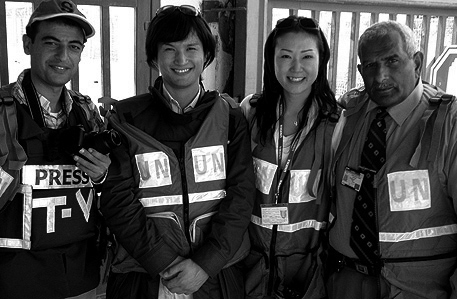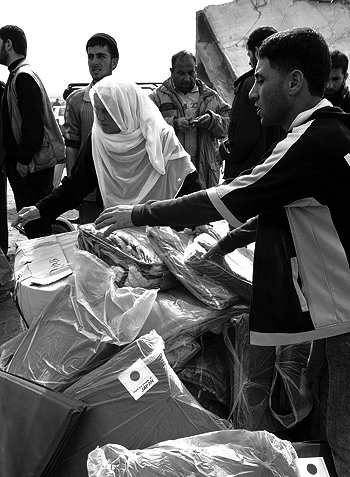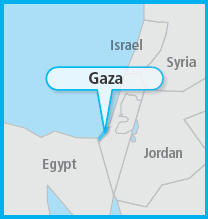Japan's Official Development Assistance White Paper 2009
Column 16 Warm Blankets for Refugees
— Japan's Assistance to Palestinian people—
Ms. Yoshiko Hasumi— United Nations Relief and Works Agency for Palestine Refugees in the Near East
On December 27, 2008, war broke out once again in the Gaza Strip, which caused many casualties. The offices, schools, and medical centers of the United Nations Relief and Works Agency for Palestine Refugees in the Near East (UNRWA) were also attacked, and during the fight, humanitarian assistance activities were greatly affected. After the ceasefire, the Government of Japan announced that it would provide emergency assistance supplies to the Gaza Strip, and it sent 29,000 blankets, 20,000 sleeping mats, and 8,000 plastic sheets.*1 Ms. Yoshiko Hasumi, who was engaged in this assistance as a UNRWA staff member, had interacted with Albanian refugees from Kosovo while she was studying in France, and she became interested in the issue of refugees. She worked for the Interim Administration Mission in Kosovo (UNMIK) and so forth, and since September 2007, she has been engaged in humanitarian assistance for Palestinian refugees at the UNRWA Gaza Office. Ms. Hasumi contributed to this ODA Report the following article about the assistance for the Gaza Strip at that time.
*1 assistance materials based on the Law Concerning Cooperation for United Nations Peace-Keeping Operations and Other Operations.
During the fight, I was temporarily assigned to Jerusalem together with my colleagues who had been working in the Gaza Strip. The emergency assistance activities by UNRWA in the Gaza Strip needed staff to support from the outside.
One of my main tasks in Jerusalem was handling donor relations. I kept close contact with donors who expressed that they would provide support for UNRWA, and based on information from my colleagues active in the Gaza Strip, I consistently informed them of what was needed in Gaza by when and to what extent, and where the relief supplies were to be sent. Humanitarian support goods steadily arrived from governments of various countries, NGOs, private companies, and individuals. A major issue was how to swiftly and smoothly send them to the Gaza Strip, since the emergency situation of fighting as well as continuous blockades by Israel hindered the transport of relief supplies to Gaza.
The supplies could be sent to the Gaza Strip only by land. During the fight, of the four security checkpoints on the Israeli barrier, only Kerem Shalom was open, and the Karni checkpoint, which is the largest gateway for importing and exporting support supplies, remained closed. The import of 100 truckloads of aid supplies was permitted per day through the Kerem Shalom checkpoint. Among this, the amount given to UNRWA was about 60 truckloads. At that time in Gaza, there were tens of thousands of refugees. During the fight, UNRWA opened its own schools and other facilities to the local residents as emergency evacuation shelters, but there were only 50 locations at the most. They accepted over 8,000 evacuating families, and the number of refugees amounted close to 50,000. For the local residents in need of emergency aid supplies, the limit of 60 truckloads was not sufficient. Depending on the situation of the fight, the checkpoints were sometimes closed, and even when they were open, all of the 60 truckloads of cargo hardly made it through due to security checks and other reasons.
In early February in 2009, the first batch of aid supplies, mattresses, from the Government of Japan arrived in Gaza, and were distributed on February 8. The distribution was done at Ezbet Abed Rabbo in the northern area of the Gaza Strip, one of the areas that was given the hardest damages during the military operations. More than 2,000 people lost their homes, and at the sites, houses turned into mountains of rubbles. The industrial area nearby was also destroyed, and the damage has still not been repaired.
Looking at grim expressions on the faces of the people lined up at the scene, I understood how the fight had destroyed and tortured their lives and hesitated to speak easily to them.
Mattresses and blankets were also supplied by other donors, but at the scene, the items from Japan were particularly well received. People expressed that the foldable mattresses with waterproof sheets were very convenient to carry around. The blankets can have been seen as emergency assistance materials and the beige color appeared to be high-quality and warm. The Government of Japan has provided significant assistance to the Gaza Strip, and the people remember this generous support. This is probably why the assistance from Japan was particularly well-received.

Together with UNRWA colleagues (Mr. Hasumi is the second from the right) (Photo: Ms. Hasumi)

Aid delivery in Ezbet Abed-Rabbo (Photo: UNRWA)

